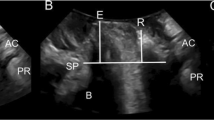Abstract
A prospective cohort study was undertaken to evaluate the impact of pregnancy and the first delivery on the defecatory symptoms and to identify associated factors. Included were 487 nulliparous pregnant women who completed four questionnaires. Flatus and fecal incontinence, constipation, and painful defecation are already present in early pregnancy and are significantly predictive for reporting symptoms after delivery, except for fecal incontinence. A third or fourth degree sphincter tear was significantly associated with fecal incontinence 12 months postpartum and with de novo fecal incontinence, while other factors associated with de novo onset of symptoms were of borderline significance. Defecation symptoms already present in early pregnancy are highly predictive for reported symptoms at 12 months postpartum except for fecal incontinence that is mainly related to anal sphincter lesion. Therefore, investigating the effects of childbirth in general on the anorectal function is not justified without knowledge of this function during pregnancy.

Similar content being viewed by others
Abbreviations
- DDI:
-
Defecatory distress inventory
- UDI:
-
Urogenital distress inventory
- BMI:
-
Body mass index
References
Chaliha C, Kalia V, Stanton SL, Monga A, Sultan AH (1999) Antenatal prediction of postpartum urinary and fecal incontinence. Obstet Gynecol 94(5 Pt 1):689–694
Hall W, McCracken K, Osterweil P, Guise JM (2003) Frequency and predictors for postpartum fecal incontinence. Am J Obstet Gynecol 188(5):1205–1207
MacArthur C, Bick DE, Keighley MR (1997) Faecal incontinence after childbirth. Br J Obstet Gynaecol 104(1):46–50
Schraffordt Koops SE, Vervest HA, Oostvogel HJ (2003) Anorectal symptoms after various modes of vaginal delivery. Int Urogynecol J Pelvic Floor Dysfunct 14(4):244–249
Sorensen M, Tetzschner T, Rasmussen OO, Bjarnesen J, Christiansen J (1993) Sphincter rupture in childbirth. Br J Surg 80(3):392–394
Zetterstrom JP, Lopez A, Anzen B, Dolk A, Norman M, Mellgren A (1999) Anal incontinence after vaginal delivery: a prospective study in primiparous women. Br J Obstet Gynaecol 106(4):324–330
MacArthur C, Glazener CM, Wilson PD, Herbison GP, Gee H, Lang GD et al (2001) Obstetric practice and faecal incontinence three months after delivery. BJOG 108(7):678–683
Sultan AH, Kamm MA, Hudson CN, Thomas JM, Bartram CI (1993) Anal-sphincter disruption during vaginal delivery. N Engl J Med 329(26):1905–1911
De Leeuw JW, Vierhout ME, Struijk PC, Hop WC, Wallenburg HC (2001) Anal sphincter damage after vaginal delivery: functional outcome and risk factors for fecal incontinence. Acta Obstet Gynecol Scand 80(9):830–834
Eason E, Labrecque M, Marcoux S, Mondor M (2002) Anal incontinence after childbirth. CMAJ 166(3):326–330
Sultan AH (1997) Anal incontinence after childbirth. Curr Opin Obstet Gynecol 9(5):320–324
Sultan AH, Kamm MA, Hudson CN, Bartram CI (1994) Third degree obstetric anal sphincter tears: risk factors and outcome of primary repair. BMJ 308(6933):887–891
Brown S, Lumley J (1998) Maternal health after childbirth: results of an Australian population based survey. Br J Obstet Gynaecol 105(2):156–161
van der Vaart CH, de Leeuw JR, Roovers JP, Heintz AP (2003) Measuring health-related quality of life in women with urogenital dysfunction: the urogenital distress inventory and incontinence impact questionnaire revisited. Neurourol Urodyn 22(2):97–104
van der Vaart CH (2001) Pelvic floor dysfunction and quality of life in women. 90-393-12668-1
Sultan AH, Kamm MA (1997) Faecal incontinence after childbirth. Br J Obstet Gynaecol 104(9):979–982
Leigh RJ, Turnberg LA (1982) Faecal incontinence: the unvoiced symptom. Lancet 1(8285):1349–1351
Jewell DJ, Young G (2001) Interventions for treating constipation in pregnancy. Cochrane Database Syst Rev 2:CD001142
Hadeem K, Dahlstrom J, Lingman G (1990) Anal sphincter function after delivery: prospective study in women with sphincter rupture and control. Eur J Obstet Gynecol Reprod Biol 35:7–13
Oberwalder M, Connor J, Wexner SD (2003) Meta-analysis to determine the incidence of obstetric anal sphincter damage. Br J Surg 90(11):1333–1337
Sultan AH, Kamm MA, Bartram CI, Hudson CN (1993) Anal sphincter trauma during instrumental delivery. Int J Gynaecol Obstet 43(3):263–270
Kamm MA (1994) Obstetric damage and faecal incontinence. Lancet 344(8924):730–733
Author information
Authors and Affiliations
Corresponding author
Appendix 1
Appendix 1
Defecation Distress Inventory
Symptom | Question | Scoring system |
|---|---|---|
Constipation * | Do you have less than 3 bowel movements a week? | Yes = symptom is present |
Do you have to strain > 25% of the time to have a bowel movements? | No= symptom is absent | |
Sensation of anal blockage | Do you ever experience a sensation of anal blockage when you have your bowel movement? | Yes = symptom is present |
No= symptom is absent | ||
Feeling of incomplete evacuation | Do you experience a feeling of incomplete evacuation after bowel movement? | Yes = symptom is present |
No= symptom is absent | ||
Painful defecation ** | Do you experience pain related to urgency for bowel movement? | Yes = symptom is present |
Do you experience pain during or shortly after a bowel movement? | No= symptom is absent | |
Fecal incontinence ** | Do you experience incontinence for liquid stool? | Yes = symptom is present |
Do you experience incontinence for solid stool? | No= symptom is absent | |
Flatus incontinence | Do you experience incontinence for gas? | Yes = symptom is present |
No= symptom is absent |
Rights and permissions
About this article
Cite this article
van Brummen, H.J., Bruinse, H.W., van de Pol, G. et al. Defecatory symptoms during and after the first pregnancy: prevalences and associated factors. Int Urogynecol J 17, 224–230 (2006). https://doi.org/10.1007/s00192-005-1351-0
Received:
Accepted:
Published:
Issue Date:
DOI: https://doi.org/10.1007/s00192-005-1351-0




